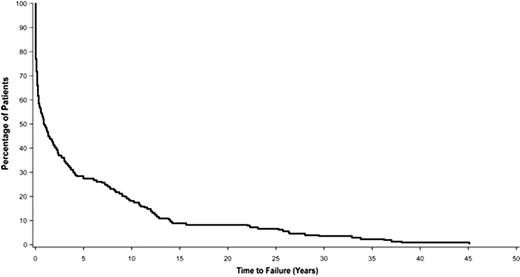Abstract
Abstract 3522
Poster Board III-459
Splenectomy has been perceived as a potentially curative treatment for patients with chronic immune thrombocytopenic purpura (ITP). Historical data demonstrate that the risk of relapse is between 33% and 50% in patients with long-term follow-up (Fabris, Br J Haematol, 2001; Schwartz, Am J Hematol, 2003). No clear pattern of time to relapse after splenectomy has been described which complicates the decision making process for physicians who are considering this irreversible therapeutic option. Splenectomized patients are at risk for: early and late surgical complications (Kojouri, Blood, 2004; Portielje, Blood, 2001); infections secondary to impaired immunity (BCSH 1996; Moffett, JAAPA, 2009; Oren 2008); thrombotic and/or cardiovascular disease (Schilling, J Thromb Haemost, 2008; Fontana, Thromb Res, 2008); and pulmonary hypertension (Schilling, J Thromb Haemost, 2008; Bonderman, Circulation, 2007). Splenectomy requires preoperative vaccinations, general anesthesia with antibiotic prophylaxis, and subsequent long-term vigilance with early antibiotic treatments. These factors not only impact the utilization of medical resources but also, due to clinically problematic outcomes, may lead to a requirement for additional treatments. OBJECTIVE: To describe the time from splenectomy to splenectomy failure among patients with chronic ITP enrolled in the eltrombopag clinical program. METHODS: Date of splenectomy and prior medications for ITP were reviewed in patients enrolled in 5 clinical trials using eltrombopag. Splenectomy was considered to have failed upon administration of the first treatment for ITP after surgery or when patients were not able to taper or interrupt concomitant ITP treatments in the 30 days following splenectomy. Of the 495 patients enrolled in the ITP program, 192 (39%) were splenectomized and 185 patients were evaluable for this analysis. The analysis does not describe overall effectiveness of splenectomy as the patient population is limited to splenectomy failure patients who required additional treatment for their ITP. RESULTS: Fifty-one percent of patients required ITP medications within 1 year of splenectomy (Figure 1). Five years after splenectomy, 27% of patients still had a response; this percentage decreased to 18% after 10 years. CONCLUSION: This retrospective analysis demonstrates that success of splenectomy appears to diminish over time. In patients requiring further ITP treatment, most splenectomized patients who relapse do so within 5 years. The treatment of chronic ITP has advanced as more data on the safety and efficacy of new medications like the thrombopoietin receptor agonists have become available. As physicians and patients become more familiar with the risks and benefits of all treatments, options other than splenectomy may be preferred for certain patients.
Kaplan-Meier: Time to Treatment Failure of Splenectomy
Cheng:GlaxoSmithKline: Research Funding. Gernsheimer:GlaxoSmithKline: Honoraria, Research Funding; Amgen: Honoraria, Research Funding. Olney:GlaxoSmithKline: Consultancy, Membership on an entity's Board of Directors or advisory committees; Amgen: Consultancy, Membership on an entity's Board of Directors or advisory committees. Bussel:Genzyme: Research Funding; GlaxoSmithKline: Equity Ownership, Membership on an entity's Board of Directors or advisory committees, Research Funding; Cangene: Research Funding; Amgen: Equity Ownership, Membership on an entity's Board of Directors or advisory committees, Research Funding; Immunomedics: Research Funding; Ligand: Membership on an entity's Board of Directors or advisory committees, Research Funding; Eisai, Inc: Research Funding; Sysmex: Research Funding; Scienta: Speakers Bureau; Shionogi: Membership on an entity's Board of Directors or advisory committees. Shah:GlaxoSmithKline: Employment. Brainsky:GlaxoSmithKline: Employment. Grotzinger:GlaxoSmithKline: Employment. Aivado:GlaxoSmithKline: Employment.
Author notes
Asterisk with author names denotes non-ASH members.


This feature is available to Subscribers Only
Sign In or Create an Account Close Modal